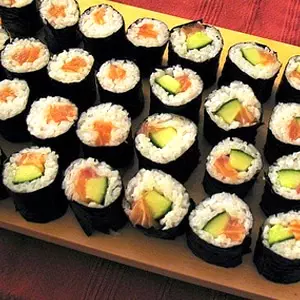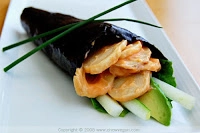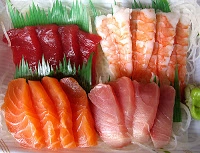~by Nikki
Sushi. Impossible after weight-loss surgery right???
Not so much!
I am a sushi-lover and have been since before surgery. In fact, I remember that my very first post on Obesity Help was a word of thanks to someone who posted that they could, in fact, eat sushi. I was so relieved!
With that information, I waited patiently until I was cleared to eat any food I like (and in some plans, that never happens, but if yours does have a “go for it…!” stage, wait until you get there before trying sushi) and went about my post-op sushi-eating career.
So in this BF Survival Guide, I’m going to run down what I know about sushi in hopes of helping you make the decision of whether or not sushi fits into YOUR post-op life.
We’re all familiar with what sushi is, right? If not, our common image of sushi is this:
It’s fish (typically raw, although some rolls come with cooked fish) wrapped in a sheet of seaweed (nori) and special rice (sushi). There are many types of sushi. Here are the most common ones:
Maki (pictured above) – the traditional roll with rice , seaweed, fish, veggies and sauce
In American culture, sushi is served in a specific way. Typically on an Asian inspired plate and you are given a small bowl, in which most people put soy sauce. On your sushi plate will be your sushi roll (or sashimi), presented artistically (the Japanese consider sushi edible art) with a small mound of wasabi (a green, pasty and VERY spicy Japanese horseradish) and some pickled ginger (a palate cleanser that is slightly sweet and sour). It is common to mix wasabi into the soy sauce to make a spicy dipping sauce.
Ok, so now that we’ve got the basics down, let’s talk choices.
For Newbies:
For most new post-ops, I’d almost exclusively say, go for sashimi. Most folks frown at that because sashimi is devoid of some of the yummier aspects of sushi rolls like the glorious sauces (wasabi mayo, etc.) that add fat and calories and the veggies (which are typically also raw). But this is your best bet if you want to be sure you don’t get sick. In the first six months, it may be challenging to finish even an order of sashimi. We advise you err on the side of sharing with someone.
We also suggest you try miso soup. Miso is a paste that has live, active cultures in it (sort of like yogurt does) that are handled carefully right up until the time they are combined with hot broth. Some miso has tofu in it (extra protein), scallions or other veggies. In general, miso has a smoky flavor that is very comforting and kind to a new pouch. If you are new-new…go with the miso soup. It’ll be enough.
For those who are good with solids but don’t have much pouch capacity yet, edamame is a great choice. Edamame are whole pods of soybeans that have been boiled and dashed in soy sauce and salt. Edamame is fun because a) it’s protein packed b) it’s tasty and c) because you have to extract the bean from the pod, it takes a while to eat so you can do your little bowl while everyone else does dinner and keep pace.
“In-betweeners” (6-18 months from surgery)
You guys have a bit more liberation in what you can eat, but often not much capacity still. There are a few things in sushi restaurants, however, that can give you great return on investment.
Tuna Tataki – it literally means tuna “pounded into pieces.” It’s seared briefly, treated with oil and vinegar and served in wedge-like slices. This is a good choice if you want your meal to look like something special.
Seaweed salad – usually when I go to a sushi restaurant, I ask for my tuna tataki on seaweed salad. Most restaurants offer seaweed salad as a side so it’s not terribly big. It’s basically the nori (but not in hard sheets like in the roll) tossed in sesame oil, sesame seeds, ginger and a few other spices. Seaweed is thought to have many beneficial properties to optimal health. Um…I just eat it because I like it.
Veterans (and those who think they are up to the challenge)
Some folks don’t ever do traditional sushi rolls again after surgery. Some alter their sushi (take the rice off). Some just eat regular sushi in moderation. Your pouch, your choice.
Several points to consider:
- If you go to a sushi restaurant that is run by traditional Japanese sushi makers, they much rather you make your alterations at the ordering stage, not after you get your food. It’s sort of an insult to deconstruct their masterpiece. Imagine drawing a moustache on the Mona Lisa because you think it’ll make her face look better. Yeah…sorta the same deal. Most sushi chefs will work with you, to the best of their ability, to give you something you’ll like and can eat.
- Knowing that us Americans are ever alarmed by simple carbs, many sushi restaurants now offer brown rice sushi as well as traditional sushi.
- If you dump on fat or sugar, avoid some of the sauces that come with or in rolls. Simply ask for them to be omitted, the chef shouldn’t mind. If he does – find another sushi joint!
- If you absolutely love your sauce, share the roll with someone. Don’t eat by yourself.
- Most of you won’t be able to finish a whole roll (depending on the size), but if you can, I advise you to eat slowly. Your fullness cues can take a minute to kick in and that could be a minute AFTER you took that “one bite too many.”
- So far as good choices in fish, most of the fishes used in sushi restaurants are beneficial from a protein standpoint. White fishes tend to be lower in fat, as opposed to something like salmon (which is not a bad choice either). This is important: since you are dealing in raw fish, if it doesn’t look, smell or feel right, SEND IT BACK!!!
Before your meal, you can also enjoy real Japanese green or white tea, which is loaded with anti-oxidants that keep those free radicals from going bonkers in your system. My sushi joint has Splenda. Carry a few packets of your favorite sweetener in your pocket just in case they don’t.
Sushi to go:
Some grocery stores carry sushi to go. I don’t recommend many. I will say, however, that our friends at Whole Foods, have a made-to-order sushi counter (with real sushi chefs) willing to make you whatever you want. They also have a variety of pre-made items and all come in whole grain varieties!
Finally, what kind of guide would this be if we didn’t run down relevant vocab? Here’s a few Japanese expressions that will serve you well in a sushi joint:
Arigato (ah-ree-gah-toe) – Thank you
Gochiso-sama deshita (Go-chee-so-sah-ma day-shee-tah) – Thank you for this great meal!
Oishii (Owee-shee-ee) – This is delicious
Omakase (oh-mah-kah-say) – this tells the sushi chef he/she is free to make you whatever they choose. I find chefs trip over themselves to impress you if you choose this route. It is perfectly appropriate to give the chef a price limit. Newbies: don’t say this.
Sabinuki (sah bee new kee) – No wasabi
So with that, I hope you have all the information you need to decide whether or not sushi will continue to be part of your life post-op. Remember: there is no absolute right or wrong decision. Just what is right for YOU. So go forth…and play with your food!
 Bariatric Foodie Play with your food
Bariatric Foodie Play with your food







2 years out and I do eat sushi..I cannot eat much, maybe a half a roll and 2 nigiri, but if eaten very slow it is very enjoyable…I couldn't eat sushi(in all its glory) at 9 months or at 12 months….I think the first time it sat well was at 18 months…
Hey Anonymous,
I'm not sure if you're the same anonymous who has commented before, but we'd love to know your name! We usually don't publish comments without a name, though, to protect ourselves from bots and spammers! So let us know who you are (a first name would suffice)! You have great insight!
LOVE sushi – I'm 18 months out and have indulged a couple times – EXCELLENT guide!
I'm three weeks out and seem to have a pouch of steel — no nausea, no upchucking, and I've been able to tolerate absolutely everything I've tried, from scrambled eggs to a dab of peanut butter and even (in a moment of supreme weakness a week out) a teensy bit of bread. I'm REALLY hoping that I'll be able to tolerate sushi after my doc approves me for solids, and this post gave me hope! Thanks, Nik!
I'm 4 months out and love to eat sushi. Its never given me issues. I can usually eat 2-3 rolls(small like California rolls) with nothing else on the side. Usually someone eats my soup for me(they always serve soup where i get my sushi). Sometimes I take off the rice, but all in all I enjoy it. It lets me feel "normal"–i guess that would be the word. lol
We have several grocery stores in the area that will make any sushi you want but instead of rolled in rice and seaweed they will roll in very thin sliced cucumber! Its delicious and CARB free! I eat it as often as possible since sushi is a favorite of mine. Ask your made to order sushi chef if they will do it for you. So yummy!
I love this! I have felt guilty eating sushi 2 or 3 times a month..but I love it so! Now I will order it as per Nik, and enjoy it guilt free!
Now, Nik..please tell me how to mark a receipe or an article as a “favorite”…I just can’t figure that out! There are so many I would like to find quickly and it takes forever to find what I came on here to find. I will be 69 in Jan and I had my WLS (RNY) june 4, 2012. I am so gratefull for the opportunity to have this done…Medicare and Humana Gold took care of everything! No co-pays..nada! I lost 157 lbs, no longer take diabetes medication, high blood sugar medication, lasix..or ANY PRESCRIPTION DRUGS AT ALL! Of course I take a ton of supplements, but I am healthier then I have ever been in my life. I have maintained my weight loss by walking and swimming. I also run 5Ks! When I get into a slump and eat something comforting…like ice cream! I come here to be inspired and to get motivated again. The most I have ever regained was 10 lbs..it really, actully snuck up on me! .I came here, read some of your blog entries, copied some new receipes and went good food shopping. The lbs came off within 24 days. This is how I cope…with you and your web site! Thank you so much and God Bless you for what you do!
Love this guide. Thank you. I can handle ebi, tamago and avocado maki. I’m 3 years out from my gastric bypass. But I also have to be gluten free (I was before surgery), so no fried or other things. They make the avocado maki small, just tiny bite size which is nice. I can handle about six of those, and one of the others and that’s about it. Good stuff. 🙂